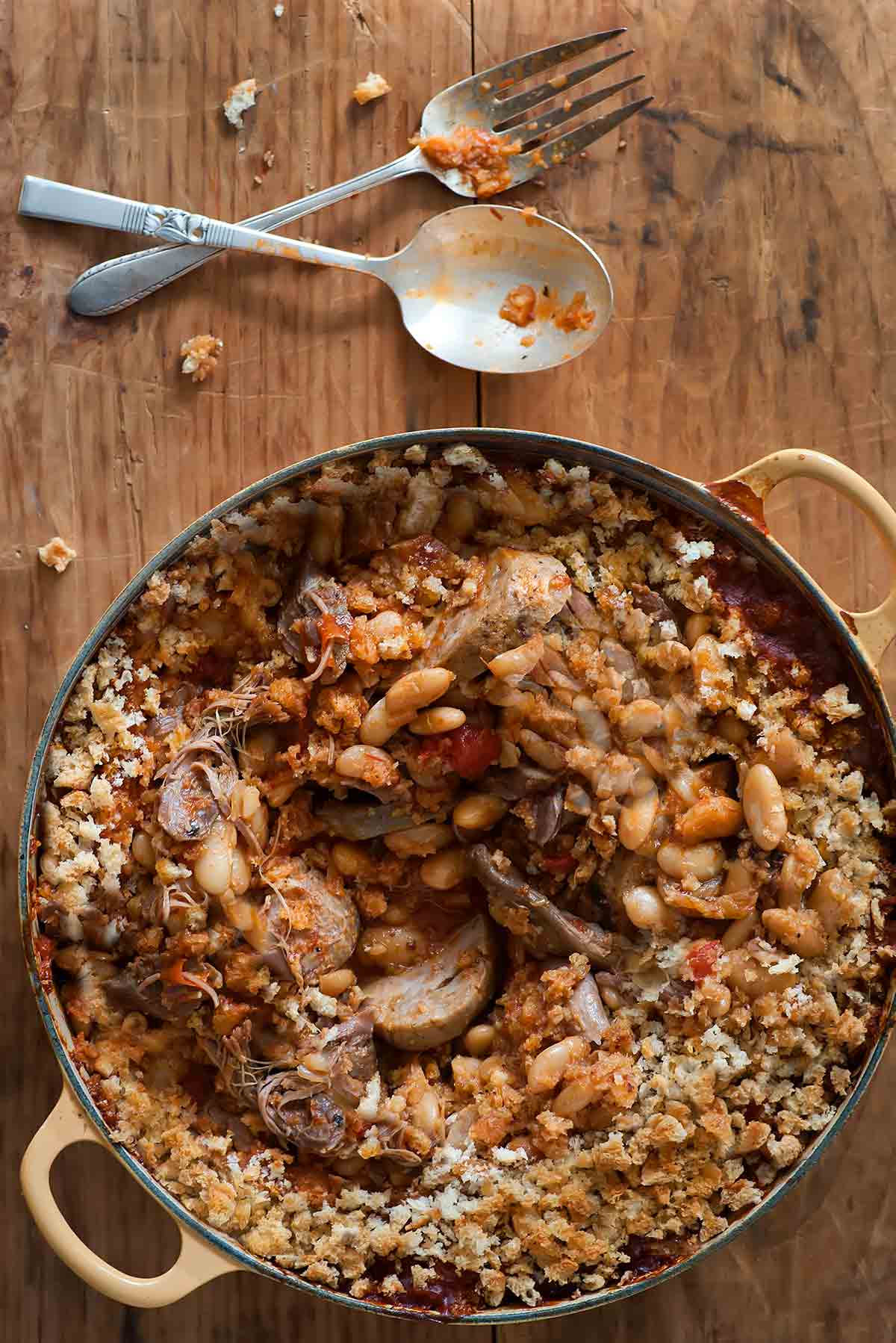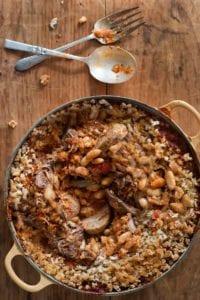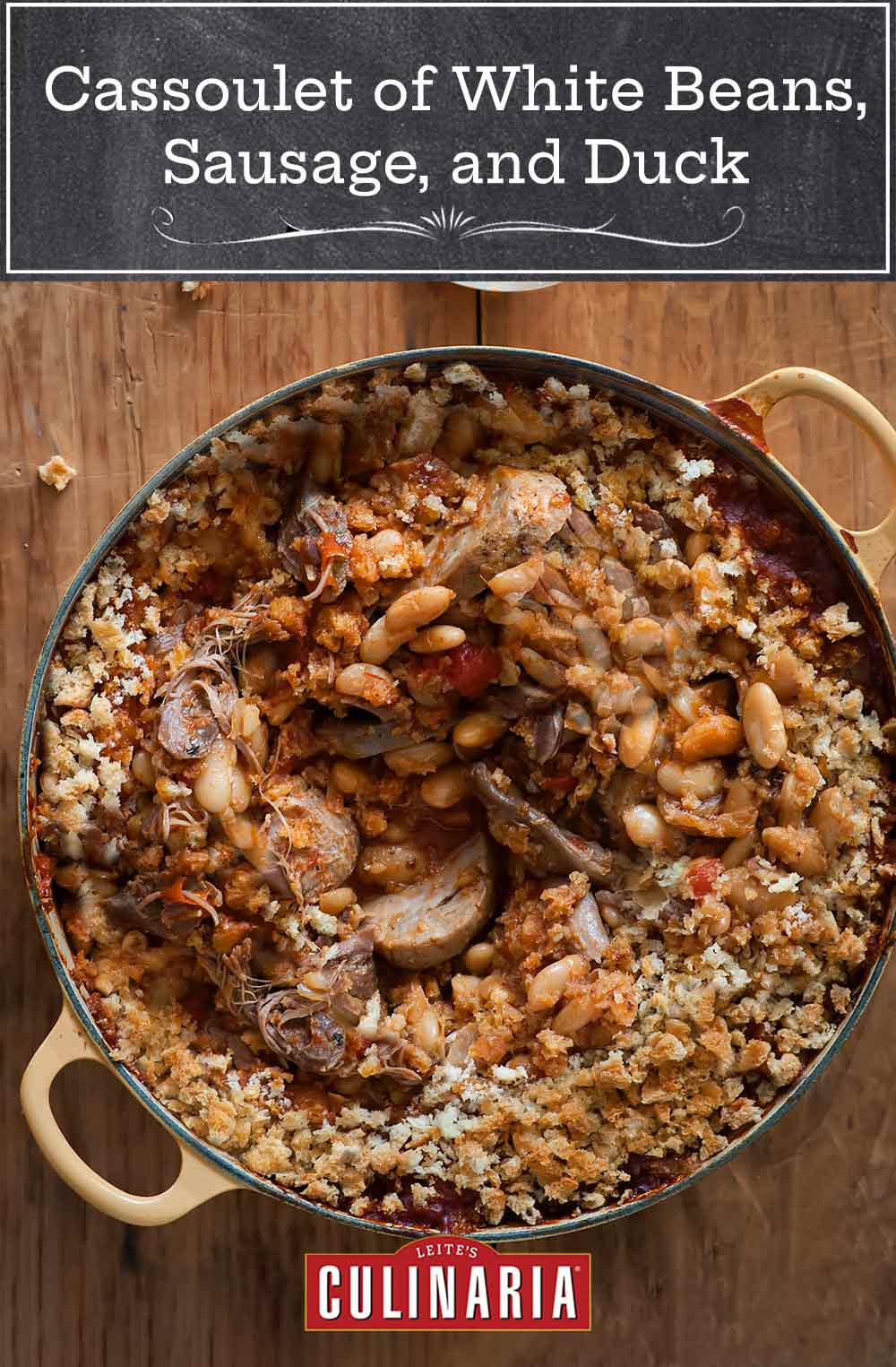
Cassoulet is a dish cooked in the winter in southwest France. It is a winter dish because it is very hearty and uses preserved meats such as sausages and duck confit cooked with white beans called flageolet. Since cassoulet is a traditional peasant dish, there is no need to buy fancy imported ingredients.–Mary Risley
What do I serve with cassoulet?
Keep things simple on the side. It’s classically served, as the author suggests, with a green salad and plenty of red table wine. If there’s anyone wanting anything afterwards, she suggests a “simple dessert such as poached oranges.”

Cassoulet of White Beans, Sausage, and Duck
Ingredients
- 2 pounds small white beans, such as Great Northern, soaked overnight in plenty of cold water
- 1/2 pound salt pork or thick-cut bacon, blanched
- 2 halved onions, and 1 chopped onion
- 1 smashed garlic clove, and 1 minced clove
- Bouquet garni composed of 4 sprigs parsley, 3 sprigs thyme, and 2 bay leaves
- 2 quarts homemade chicken stock or canned chicken broth
- 1 pound pork sausages
- 4 tablespoons rendered duck fat or olive oil
- 1 cup dry white wine
- 1 1/2 pounds red tomatoes, peeled, seeded, and chopped, or one 28-ounce can of tomatoes
- Coarse salt
- Freshly ground black pepper
- 1 whole confited duck, cut in 8 pieces, or 8 whole legs, halved on the bone
- 1 1/2 cups toasted bread crumbs
Instructions
- To prepare the beans, drain and place them in an 8-quart casserole with the bacon, the halved onions, the smashed garlic, bouquet garni, and chicken stock. Bring to a boil over moderately high heat. Reduce the heat and gently simmer over low heat, uncovered, for about an hour.
- Preheat the oven to 350°F (180°C).
- Remove the bacon and cut it into 1-inch pieces. Strain the beans, reserving both the beans and the cooking liquid and discarding the onions and bouquet garni. Place the beans in a bowl.
- To cook the sausages, prick each one in a couple places with a fork and place them in the bottom of a 10-inch saute pan with 1/4 inch water. Cook over medium heat, turning from time to time, until the water has evaporated and the sausages are browned on all sides, about 5 minutes. Remove them and slice them at an angle into 1-inch pieces.
- Add 2 tablespoons of the duck fat to the pan with the sausage drippings along with the chopped onion and cook, stirring from time to time until the onion is softened, about 5 minutes. Add the minced garlic and continue to cook and stir for another minute. Add the white wine and cook for another minute. Stir in the tomatoes and continue cooking for another 5 minutes, stirring from time to time. Season well with salt and pepper and remove from the heat.
- To assemble the cassoulet, layer 1/3 of the beans on the bottom of the casserole and add half the bacon or salt pork, sausages, and duck confit. Cover this layer with half the tomato mixture. Repeat with another third of the beans and the remaining bacon, sausages, and duck confit. Cover this with the rest of the tomatoes and then the beans. Add salt and pepper to taste to the reserved bean-cooking liquid. Pour enough of the bean liquid into the casserole to come up just to the top of the beans. (You can cover and refrigerate the assembled cassoulet for several hours.)
- Cover the entire cassoulet with bread crumbs, dot with the remaining 2 tablespoons duck fat, and bake for 45 to 75 minutes, or until the bread crumbs have formed a crisp crust. You can break through the crust with the back of a spoon three or four times during the cooking to allow the juices to help form that crust.
- Let your cassoulet cool slightly prior to serving.

Explore More with AI
Nutrition
Nutrition information is automatically calculated, so should only be used as an approximation.
Recipe Testers’ Reviews
Select a Tester
I went through a trial run of this cassoulet, then made it again to serve to weekend guests at our country home. This is just the best comfort food and my guests couldn’t stop praising it.
There were some changes I made so it work better us the second time. We made our own duck confit, as it’s impossible to find it in this small community. However, most city folk would probably buy it ready made. To control what went in it, we used our own sausage as well. We made the dish over a period of several days so that we could assemble it the day our friends were here and not spend all day in the kitchen.
We made the beans first, soaking them overnight and preparing them the next day. We used cranberry beans the second time and found they held their shape beautifully and were creamy and nice to look at in the final dish. We also boiled the beans in water rather than in chicken stock and discarded the water after. We used the chicken stock if any liquid was needed later.
I found that removing the duck from the bone and discarding the skin for the final dish made it easier to eat and serve at the table. I also found that the dish took only 45 minutes in a 350°F oven to meld the flavours and make the crust crispy. This is, perhaps, because I made it in stages then reconstructed the dish the day of the dinner party.
Beware: I made half the recipe and found it was enough to serve 8 generously.
As expected with cassoulet, this involved quite a bit of preparation. None of it was especially difficult, but it did require several days. Once I had made the duck confit, a step you can skip by purchasing it, the rest was simple. Of course, this is still not a one-day recipe. The beans need an overnight soaking. The rest is just a matter of a couple of quick preps of the sausage and tomatoes, and then assembly. I did, however, take the extra step of removing the meat from the bones for convenience in serving. I put this together several hours ahead of my dinner party, topping it with the crumbs and extra fat (which it didn’t really need) just before popping it in the oven.
The result was wonderful! The kitchen filled with steamy smells of herbs, sausage, onion, and garlic. The beans were infused with flavor. The duck was so tender it melted into the other ingredients. Finally, I had recreated the cassoulet that made me fall in love with bistros on my first trip to France. It even seduced my health conscious friends. No one left a morsel.












First time making Cassoulet! We sampled a bit–it’s delicious! I will let it cool, then refrigerate it, and re-warm for tomorrow’s dinner. It’s been quite the journey–thank you for your thoughtful guidance along the way–very much appreciated.
I’m off now, to bake a loaf of bread to accompany this…………
It looks delicious, Elaine. Enjoy!
Thought I should add a photo of the plated dish. I served it with a loaf of freshly-baked bread.
Terrific dish for a cold winter’s day–we loved it!
Gorgeous, Elaine!
I hope to prepare this recipe soon (made the duck stock yesterday using your recipe). I have a few questions re using salt pork in lieu of thick-cut bacon.
In step #1, am I correct in assuming the piece of salt pork is placed in the casserole with all the other ingredients?
In step #3, is that piece of salt pork now cut into small pieces, set aside, to be incorporated into the “layering” that is discussed in step #6?
TIA,
Elaine
Correct, Elaine. Treat the salt pork just as you would thick cut bacon. Be sure that you blanch your salt pork before using it though, or your dish may be overly salty. To blanch it, cook it in boiling water for about 5 minutes, then drain it and let it cool slightly before using.
Thank you for your timely reply.
Much appreciated.
You’re welcome, Elaine. Please let us know how it turns out.
We made this as a trial run for an upcoming late-autumn meal. It was superbly delicious. What I love about it is it takes so much less time than other cassoulet recipes I’ve seen on the Internet. We bought D’Artagnan duck confit, which made it quicker. (Tester Cindi made her own!) It serves a lot, but with all the picking and snacking, it was gone in a day.
Tuck, I’m delighted you enjoyed the cassoulet. It’s a fantastic dish!